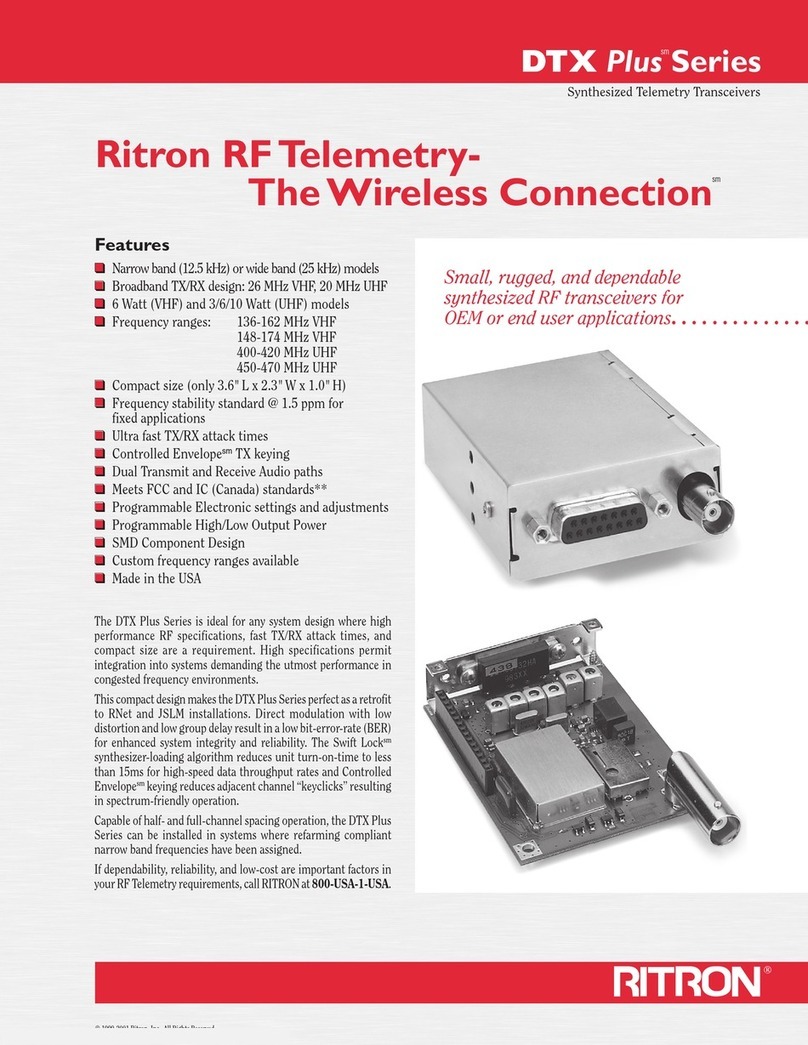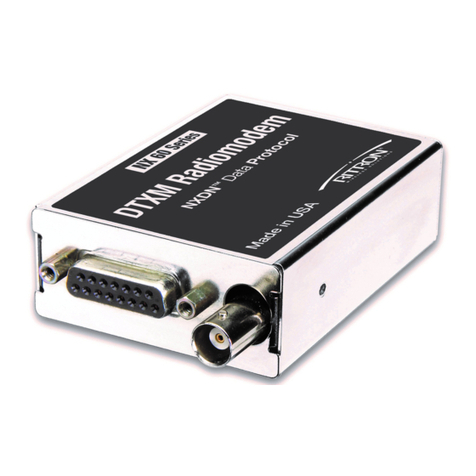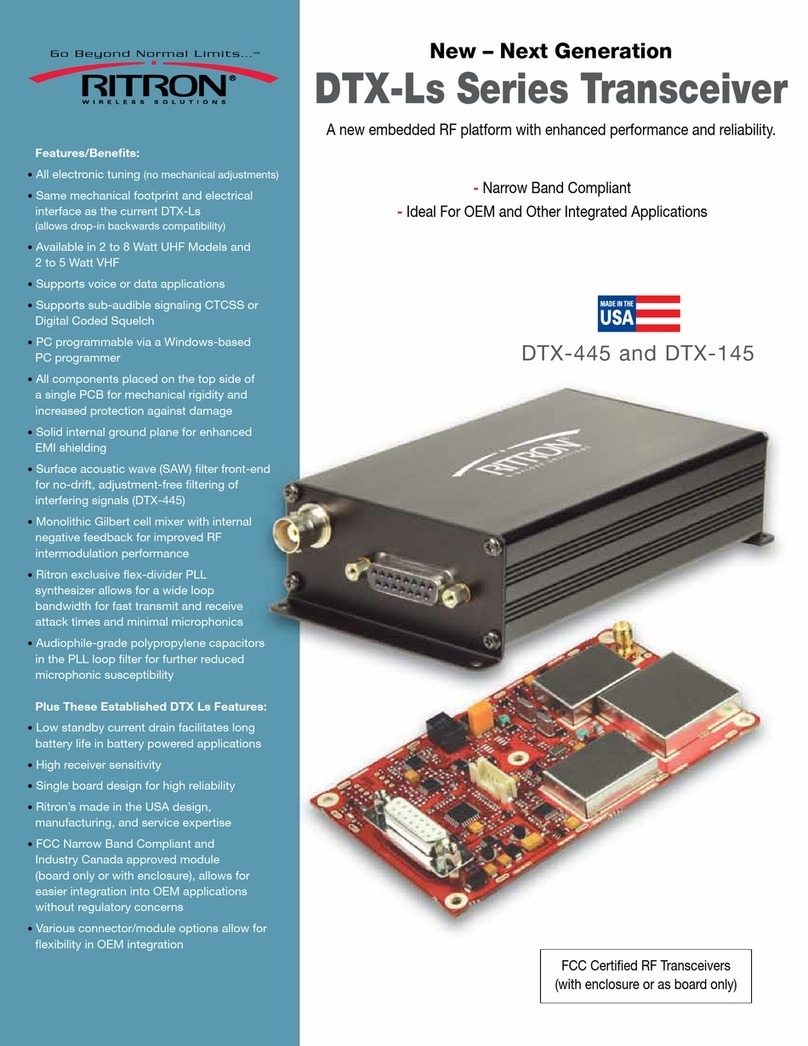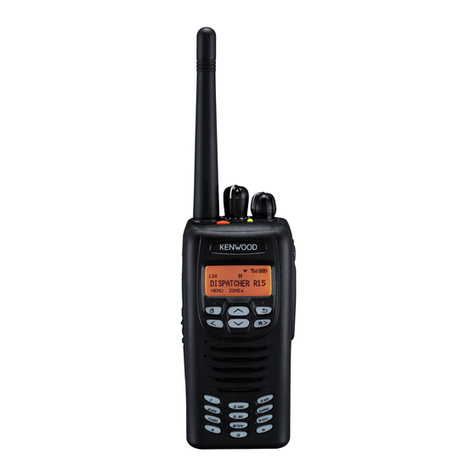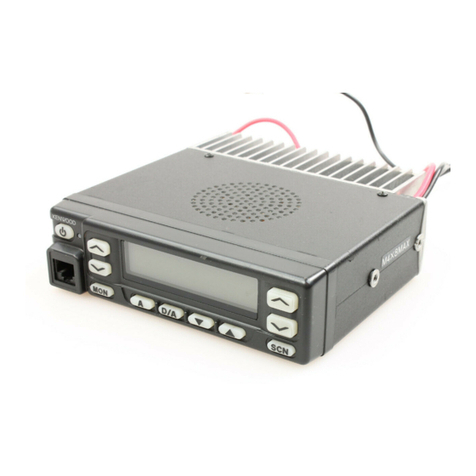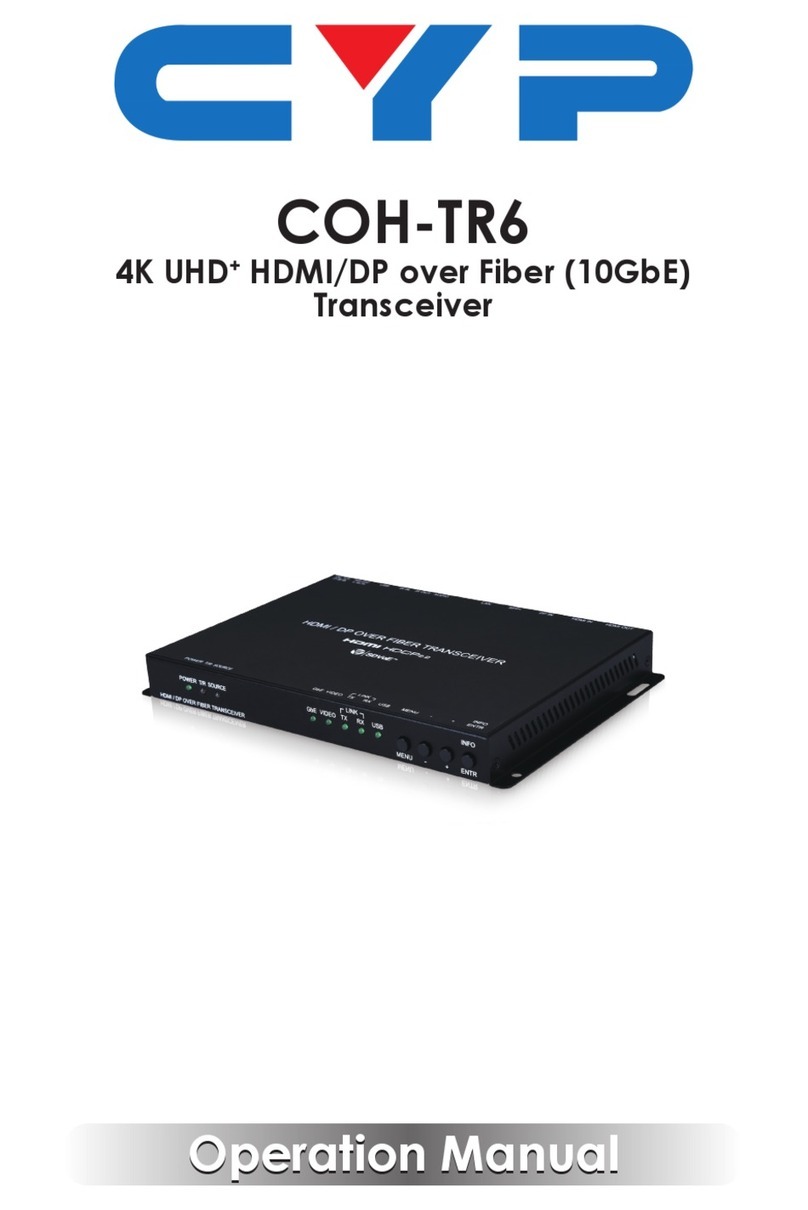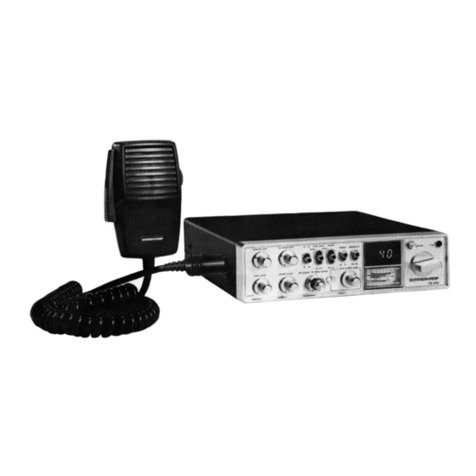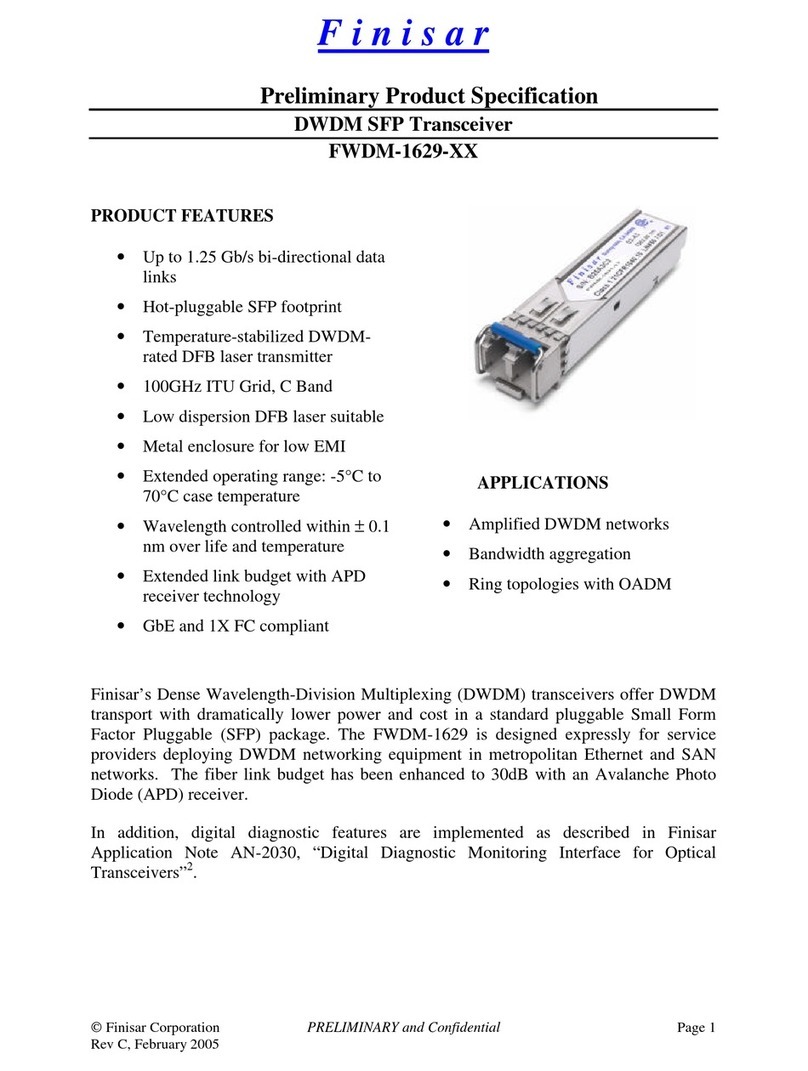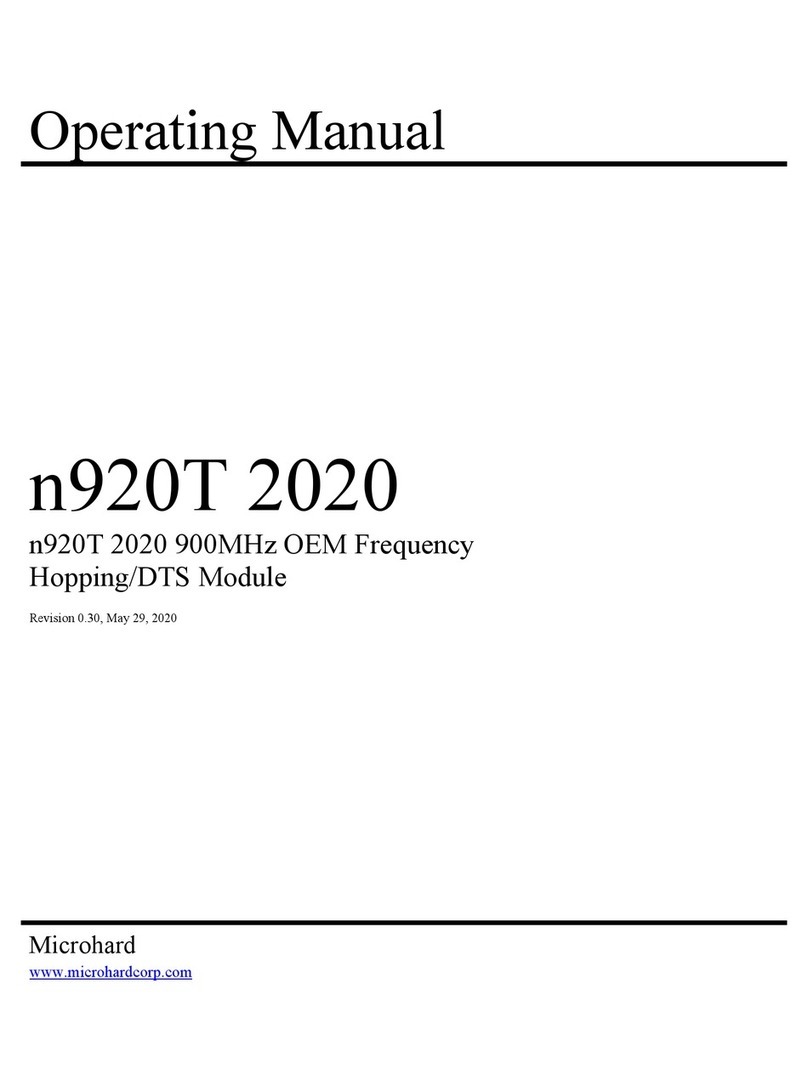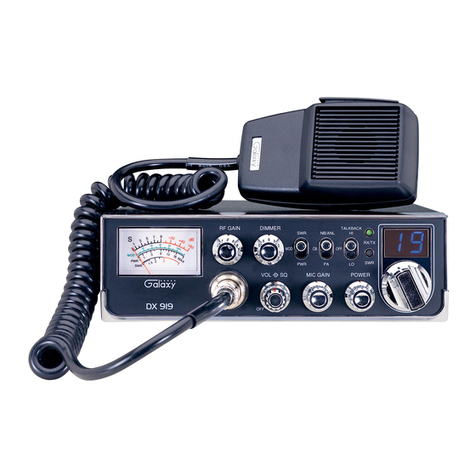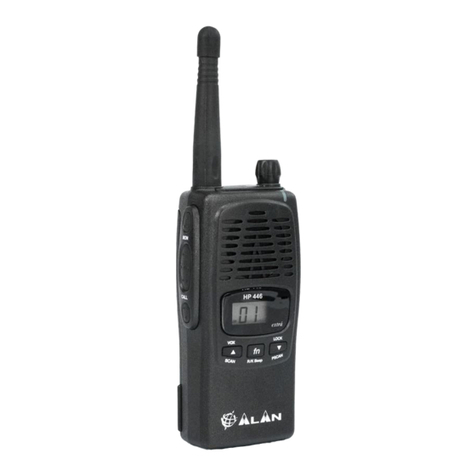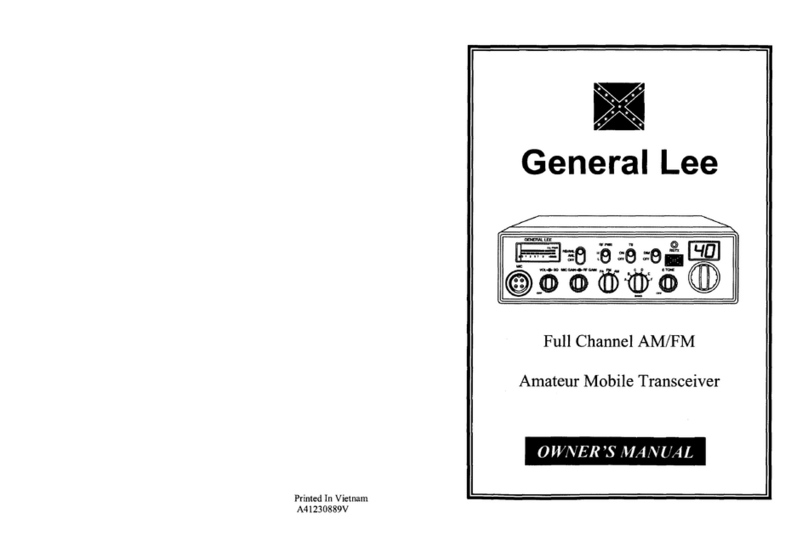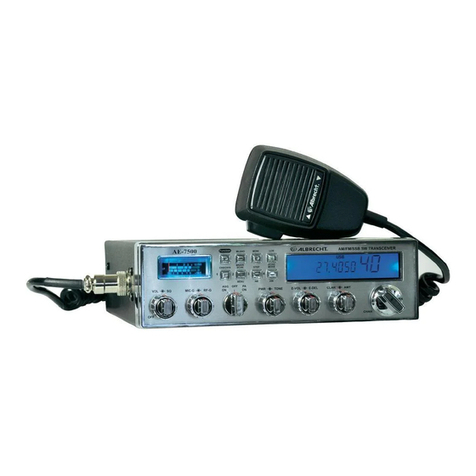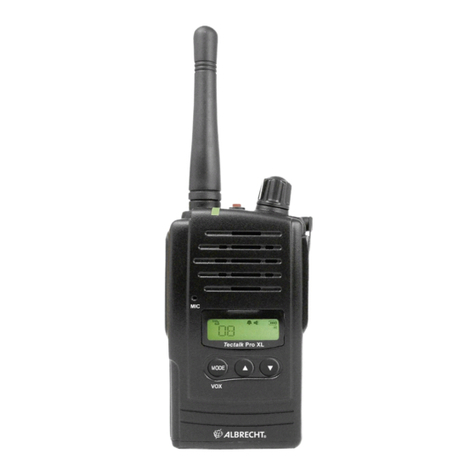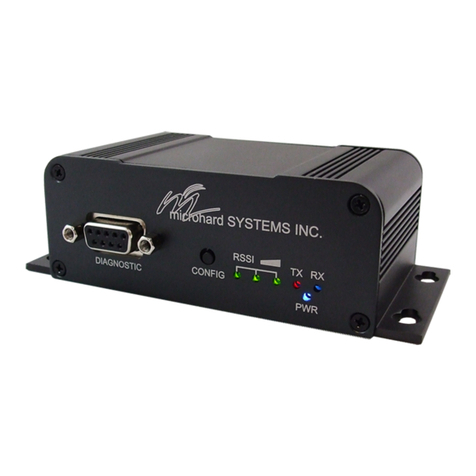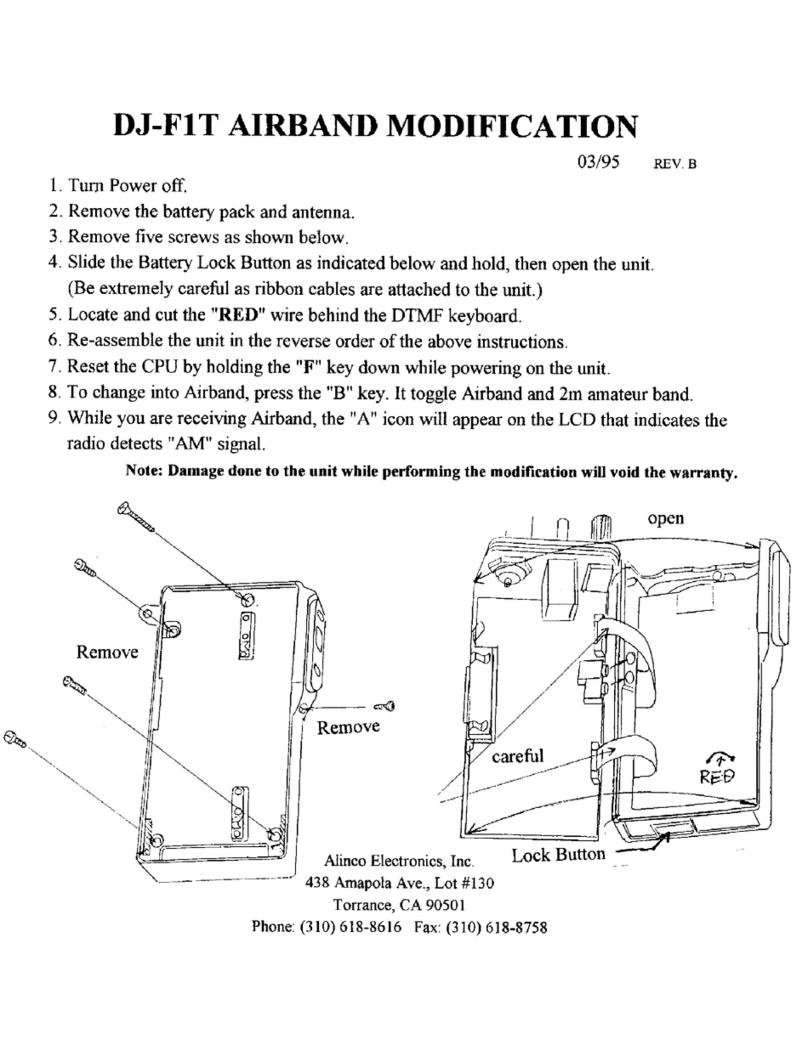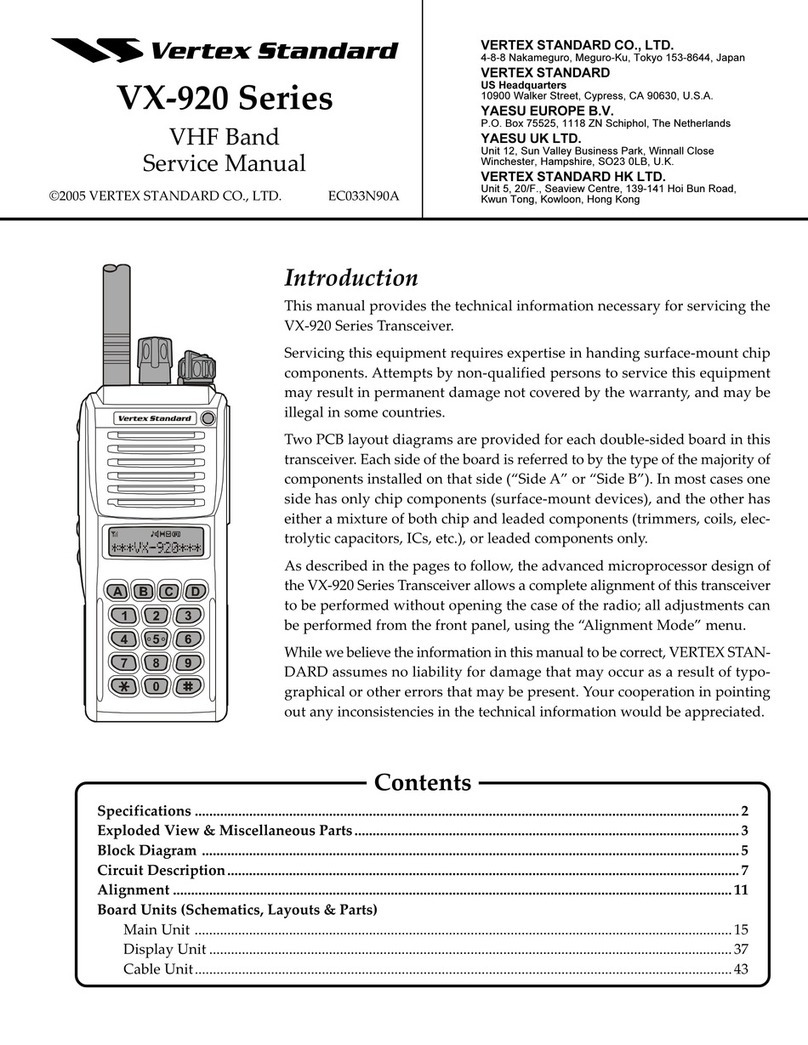Ritron DTX-165-0 Operating and maintenance manual

RITRON, INC. PRELIMINARY 08-16
RITRON MODELS DTX-X65 SERIES
PROGRAMMABLE
FM TRANSCEIVER MODULES
MAINTENANCE & OPERATING
MANUAL
PRELIMINARY!
FOR USE ONLY BY AUTHORIZED SERVICE/MAINTENANCE PERSONNEL

TABLE OF CONTENTS
I DTX MODULES
1 INTRODUCTION
1.1 GENERAL
1.2 MODEL IDENTIFICATION
1.3 FCC REGULATIONS
2 MODELS DTX-965 SPECIFICATIONS
2.1 GENERAL
2.2 TRANSMITTER
2.3 RECEIVER
3 DTX-965 INPUT/OUTPUT CONNECTOR
4 ACCESSORIES
5 OPERATION
5.1 CHANNEL SELECTION
5.2 POWER SUPPLY VOLTAGE
5.3 DUTY CYCLE/KEY-DOWN LIMITATIONS
5.4 OPERATING MODES
5.5 RNET COMPATIBILITY MODE
6 PROGRAMMING
6.1 PC PROGRAMMING KIT
6.2 LOADING THE PROGRAMMING SOFTWARE
6.3 COMPUTER SOFTWARE COPYRIGHTS
6.4 USING THE PROGRAMMING SOFTWARE
6.5 PROGRAMMER MENUS
II MAINTENANCE
7 IMPORTANT MAINTENANCE INFORMATION
8 THEORY OF OPERATION
8.1 DTX-965 RF BOARD
8.2 CONTROL/LOADER BOARD
9 HARDWARE OPTIONS
10 ALIGNMENT
10.1 REQUIRED TEST EQUIPMENT
10.2 ALIGNMENT PROCEDURE

1 INTRODUCTION
1.1 GENERAL
The RITRON High Power DTX Plus modules are programmable 2-way radios, which operate
either in the VHF or UHF professional FM communications bands as well as a number of other
bands in the 220 MHz, 350 MHz, and 900 MHz region. Each of eight channels can be
programmed to contain a unique set of operating frequencies. The High Power DTX Plus module
is made up of two PC boards, an RF board and a control/loader board. These two boards are
enclosed in a metal case with two connectors on one end; a 50 ohm BNC connector for
connection to an antenna and a DB-15 sub-miniature connector for control input/output and a
power input connector on the other end.
In addition, the RF board/heat sink assembly is available as a stand-alone unit for system
integrators.
1.2 MODEL IDENTIFICATION
The part number system for the High Power DTX Plus module is as follows:
The module has a part number in the form of “DTX-A65-BCDEF” where:
A is the major frequency band designator:
1=VHF (136-174 MHz bands)
2=216-222 MHz band
3=340-400 MHz bands
4=UHF (400-430 MHz and 450-470 MHz bands)
9=896-901 MHz band
B is the sub-band designator:
G=136-162 for #1 above , 340-360 MHz for #3 above, and 400-430 MHz for #4 above.
A=420-440
B=430-450
O=148-174 for #1 above, 216-222 for #2 above, 360-380 for #3 above, 450-470 for #4
above, and 896-901 for #9 above.
M=380-400 for #3 above.
C=470-490
T=490-512
Note that not all of the sub-bands listed above may be available, and that other sub-
bands may become available.
C is the connector designator:
B=BNC connector
D designates the IF bandwidth:
W=wide (25/30 kHz channel bandwidth)
N=narrow (12.5/15 kHz channel bandwidth)
S=very narrow (5/ 6.25/ 7.5 kHz channel bandwidth)
E designates the maximum power level:
30=30 watts
F designates whether the control/loader board has a regulator and if so, at what current level:
I=high current regulator; the unit operates from 10-15 volts at 30 watts max.
Example: A DTX-265-OBN30I would be a VHF module for operation between 216 and 222 MHz
with a BNC RF connector, narrow (12.5 kHz channel bandwidth) IF bandwidth, 30 watts
maximum output power, and an internal regulator to allow operation from 10 to 15 volts.

The part number system for a stand-alone RF board/Heat Sink assembly is the same as that for a
module except that “F” designator (regulator option) does not exist and a “D” is appended at the
end.
1.3 FCC REGULATIONS
1.3.1 LICENSING
For those frequency bands governed by FCC rules, the FCC requires that the radio owner obtain
a station license for his radio before using the equipment to transmit, but does not require an
operating license or permit. The station licensee is responsible for proper operation and
maintenance of his radio equipment, and for ensuring that transmitter power, frequency and
deviation are within the limits specified by the station license. This includes checking the
transmitter frequency and deviation periodically using appropriate methods. Note also, that
wideband operation (25/30 kHz channel bandwidth) may not be permitted.
1.3.2 PRODUCT CERTIFICATION
The High Power DTX modules are certified by the FCC for operation in the United States and by
Industry Canada for operation in Canada on certain frequency bands and sub-bands for
transmission of either voice or data signals when aligned according to the alignment procedure
for the proper bandwidth and when operated as a complete unit in the metal case. Operation of
the RF board as a stand-alone unit or in combination with any other equipment, in any mode
outside the alignment procedure, or with the clipper filter electronically disabled will require the
filing of a new type acceptance application with the FCC by the user.
1.3.3 SAFETY STANDARDS-RF EXPOSURE (DTX-165/265, 365/465))
RF ENERGY EXPOSURE AWARENESS AND CONTROL INFORMATION, AND
OPERATIONAL INSTRUCTIONS FOR FCC OCCUPATIONAL USE REQUIREMENTS:
BEFORE USING THIS 2-WAY RADIO, READ THIS IMPORTANT RF ENERGY AWARENESS
AND CONTROL INFORMATION AND OPERATIONAL INSTRUCTIONS TO ENSURE
COMPLIANCE WITH THE FCC’S AND IC’S RF EXPOSURE GUIDELINES.
NOTICE: This radio is intended for use in occupational/controlled conditions, where users have
full knowledge of their exposure and can exercise control over their exposure to meet FCC/IC
limits. This radio device is NOT authorized for general population, consumer, or any other use.
This 2-way radio uses electromagnetic energy in the radio frequency (RF) spectrum to provide
communications between two or more users over a distance. It uses radio frequency (RF) energy
or radio waves to send and receive calls. RF energy is one form of electromagnetic energy. Other
forms include, but are not limited to, electric power, sunlight and x-rays. RF energy, however,
should not be confused with these other forms of electromagnetic energy, which when used
improperly can cause biological damage. Very high levels of x-rays, for example, can damage
tissues and genetic material.
Experts in science, engineering, medicine, health and industry work with organizations to develop
standards for exposure to RF energy. These standards provide recommended levels of RF
exposure for both workers and the general public. These recommended RF exposure levels
include substantial margins of protection. All 2-way radios marketed in North America are
designed, manufactured and tested to ensure they meet government established RF exposure
levels. In addition, manufacturers also recommend specific operating instructions to users of 2-
way radios. These instructions are important because they inform users about RF energy
exposure and provide simple procedures on how to control it. Please refer to the following
websites for more information on what RF energy exposure is and how to control your exposure
to assure compliance with established RF exposure limits.
http://www.fcc.gov/oet/rfsafety/rf-faqs.html
http://www.osha.gov/SLTC/radiofrequencyradiation/index.html

Federal Communications Commission Regulations:
The FCC rules require manufacturers to comply with the FCC RF energy exposure limits for
mobile 2-way radios before they can be marketed in the U.S. When 2-way radios are used as a
consequence of employment, the FCC requires users to be fully aware of and able to control their
exposure to meet occupational requirements. Exposure awareness can be facilitated by the use
of a label directing users to specific user awareness information.
The DTX 2-way radio has an RF exposure product label. Also, this DTX manual includes
information and operating instructions required to control your RF exposure and to satisfy
compliance requirements.
Compliance with RF Exposure Standards:
The DTX two-way radio is designed and tested to comply with a number of national and
international standards and guidelines (listed below) regarding human exposure to radio
frequency electromagnetic energy. This radio complies with the IEEE and ICNIRP exposure limits
for general population/uncontrolled RF exposure environment at duty factors of up to 50% talk
and 50% listen and is authorized by the FCC for occupational use. In terms of measuring RF
energy for compliance with the FCC exposure guidelines, your radio antenna radiates
measurable RF energy only while it is transmitting (during talking), not when it is receiving
(listening) or in standby mode. The DTX two-way radio complies with the following RF energy
exposure standards and guidelines:
• United States Federal Communications Commission, Code of Federal Regulations; 47 CFR §§
2 sub-part J.
• American National Standards Institute (ANSI) / Institute of Electrical and Electronic Engineers
(IEEE) C95. 1-1992.
• Institute of Electrical and Electronic Engineers (IEEE) C95.1-1999 Edition.
Copyright Telecommunications Industry Association
To control exposure to yourself and others and ensure compliance with the
occupational/controlled environment exposure limits always adhere to the following procedures:
Guidelines:
• User awareness instructions should accompany device when transferred to other users.
• Do not use this device if the operational requirements described herein are not met.
Instructions:
• Transmit no more than the rated duty factor of 50% of the time. To transmit (talk or send data),
assert the PTT input pin. To receive calls, un-assert the PTT input. Transmitting 50% of the time,
or less, is important because this radio generates measurable RF energy exposure only when
transmitting (in terms of
measuring for standards compliance).
• Transmit only when people are at least the recommended minimum lateral distance away, as
shown in Table 1, from a properly installed according to installation instructions, externally-
mounted antenna.

NOTE - Table 1 lists the recommended minimum lateral distance for bystanders in an
uncontrolled environment from transmitting types of antennas (i.e., monopoles over a ground
plane, or dipoles) at several different ranges of rated radio power for mobile radios installed on a
vehicle. For mobile applications, this transmitter is restricted for use only in a locomotive, and the
antenna must be mounted on the metal roof of the locomotive.
Table 1. Rated Power and Recommended Lateral Distance for quarter-wave ground plane
antenna:
Rated Power of DTX Recommended Minimum Lateral
2-way Radio Distance from Transmitting Antenna
DTX-965(896-901 MHz)
30 Watts or less: 26.5 inches (67.4 cm)
Antennas
• Install antennas taking into account the recommended minimum lateral distances in Table 1.
These antenna installation guidelines are limited to antennas with appropriate ground planes.
The antenna installation should additionally be in accordance with:
a.) The requirements of the antenna manufacturer/supplier.
b.) Instructions in this manual including minimum antenna cable lengths.
c.) Antennas other than those shown in Table 1 must be tested with the High Power DTX
module for RF exposure compliance in the environment in which it is to be used per the
FCC’s OET Bulletin 65, Edition 97-01 or Industry Canada RSS-102.
Use only a unity gain, quarterwave antenna or equivalent antenna per the frequency range for the
device as specified in Table 1. Unauthorized antennas, modifications, or attachments could
damage the radio and may violate FCC regulations.
Antennas for this transmitter must not be co-located or operated in conjunction with any other
antenna or transmitter. All information herein pertains to the antenna not co-located to other
antennas or transmitters.
Approved Accessories
• This radio has been tested and meets the FCC RF exposure guidelines when used with the
Ritron accessories supplied or designated for this product. Use of other accessories may not
ensure compliance with the FCC’s RF exposure guidelines, and may violate FCC regulations.
• For a list of Ritron approved accessories see this user manual, or visit the following website
which lists approved accessories: www.ritron,com
Contact Information:
For additional information on exposure requirements or other information, contact Ritron at (317)
846-1201 or at www.ritron.com.

2 SPECIFICATIONS
2.1 GENERAL
FCC/IC Identifier
Model FCC IC
DTX-165-0 AIERIT34-1650 1084A-RIT341650
DTX-265-0 AIERIT34-2650 1084A-RIT342650
DTX-365-0 AIERIT34-3650 1084A-RIT343650
DTX-465-0 AIERIT34-4650 1084A-RIT344650
DTX-965-0 AIERIT34-9650 1084A-RIT349650
FCC Rule Parts 90
Industry Canada Rule Parts RSS-119
Frequency Ranges
DTX-165-0 136-174 MHz
DTX-265-0 216-217MHz, 220-222 MHz
DTX-365-G 340-360 MHz*
DTX-365-0 360-380 MHz*
DTX-365-M 380-400 MHz*
DTX-465-G 400-430 MHz*
DTX-465-A 420-440 MHz*
DTX-465-B 430-450 MHz*
DTX-465-0 450-470 MHz
DTX-465-C 470-490 MHz*
DTX-465-T 490-512 MHz*
DTX-965-0 896-901 MHz, 935-940MHz
* Not Available Yet
Number of Channels 8
Transmit/Receive Spacing Up to the span of the sub-band
Mode of Operation Simplex or Half Duplex
Frequency Control PLL Synthesizer
Channel Increment (Synthesizer step size)
DTX-165/265 2.5 kHz/3.125 kHz
DTX-365/465 6.25 kHz
DTX-965 12.5kHz
Emissions Bandwidth
Very narrow mode 4.0-4.8 kHz depending upon modulation
Narrow Mode 11 kHz
Wide Mode 16 kHz
Frequency Stability
-30 C to +50 C +/-1.0 ppm
-40 C to +60 C +/-1.5 ppm
Supply Voltage 11 to 16 VDC
RF Input/Output Connector BNC standard

Supply Input Connector 2-Pin Molex
Data Interface 15 pin subminiature D type
Operating Temperature -30 to +60 C
Maximum Dimensions (L x W x H) 6.6” x 5.0” x 2.4” including connectors
Weight 35 oz.

2.2 TRANSMITTER( DTX-965)
Operating Bandwidth Up to the span of the sub-band
RF Output Power (internally adjustable) 5 to 30 watts
Duty Cycle 5 to 100 % depending upon ambient
temperature(see chart elsewhere in
manual)
RF Load Impedance 50 ohms
Modulation Distortion (per TIA/EIA 603) 5 % max.
Modulation Frequency Response (+1/-3 dB, ref 1 kHz)
Narrowband wideband versions:
w pre-emphasis 200 Hz to 2500 Hz
w/o pre-emphasis 50 Hz to 2700 Hz
Transmitter Attack Time: 10 ms max
Spurious and Harmonics -13 dBm max.
FM Hum and Noise
Narrowband (12.5/15 kHz) operation 45 dB min.
Group Delay Variation (Within Frequency Response) 5 us max.
Current Drain Depends upon supply voltage
(see chart elsewhere in manual).
AUX IN adjustment range (60% rated dev.)
w pre-emphasis (@ 1 kHz) 20 to 650 mVrms
w/o pre-emphasis (flat) 20 to 600 mVrms

2.3 RECEIVER (DTX-965)
Operating Bandwidth Up to span of the sub-band
Sensitivity (12 dB SINAD @ 1 kHz w de-emphasis) 0.25 uV (-119.0 dBm) typical
RF Input Impedance 50 ohms nominal
Adjacent Channel Selectivity
+/- 12.5 kHz w narrow IF 60 dB min.
Spurious and Image Rejection
IF/2 100 dB min.
Image & other 70 dB min.
Intermodulation Rejection 80 dB min.
FM Hum and Noise
Very narrowband (5/6.25/7.5 kHz) operation 40 dB min.
Narrowband (12.5/15 kHz) operation 45 dB min.
Wideband (25/30 kHz) operation 50 dB min.
Conducted Spurious -70 dBm max.
Receive Attack Time (transmit to receive) 10 ms max.
Carrier Detect Attack Time 5 ms max.
Audio Distortion 5 % max.
Audio Response (+1/-3 dB, ref 1 kHz)
Narrowband and wideband versions:
w de-emphasis 400 Hz to 2500 Hz
w/o de-emphasis 100 Hz to 3500 Hz
Very narrowband versions:
w/o de-emphasis 100 Hz to 1500 Hz
Receive Current Drain Depends upon supply voltage options
(see chart elsewhere in manual).
AUX OUT Adjustment Range (60 % rated dev.)
w de-emphasis (@ 1 kHz) 20 to 800 mVrms open circuit
w/o de-emphasis (@1 kHz) 35 to 900mVrms open circuit

3 DTX INPUT/OUTPUT CONNECTORS
DB-15 Connector Pinout
Pin Number Name Description Comments
1 CS0 Channel Select low bit
2 CS1 Channel Select mid bit
3 CS2 Channel Select high bit
4 MIC IN Microphone Input Input for microphone type
signals to be transmitted.
Signals at this input are pre-
emphasized, limited, and
filtered. This input is disabled in
very narrowband mode.
5 CSN High/Low Power or Channel 1/2 (in RNet Mode)
6 NC No Connection
7 AUX IN Auxiliary Input Wideband input for data.
8 AUX OUT Auxiliary Output Wideband output for data.
9 PGN IN/OUT Programming I/O External programmer
connects here.
10. CTS Clear to Send Asserted when
transmitter can accept
modulation.
11. RX MON Monitor Breaks squelch in receive.
12. AUDIO OUT Audio PA Output Output of audio PA.
13. DCD Carrier Detect Carrier detect output.
14. PTT/RTS Push to Talk Activates transmitter.
15. GND Ground Negative supply point and
reference for all inputs.
2-Pin Molex Connector
1 +Vsupply +10-16VDC
2 GND Ground
Pinout Description
Pin Number Description
1 CS0-Least significant bit of the channel select lines. Active high 5 volt
TTL/CMOS level. Internal 10 kpull-up to +5 volts.
2 CS1-Mid bit of the channel select lines. Active high 5 volt TTL/CMOS level.
Internal 10 kpull-up to +5 volts.

3 CS2-Most significant bit of the channel select lines. Active high 5 volt
TTL/CMOS level. Internal 10 kpull-up to +5 volts.
Channel CS2 CS1 CS0
1 0 0 0
2 0 0 1
3 0 1 0
4 0 1 1
5 1 0 0
6 1 0 1
7 1 1 0
8 1 1 1
0 = Logic low
1 = Logic high
Note: Due to the internal pull-up resistors, the unit defaults to channel 8 if the
channel pins are left open (unconnected). Channel 8 would be the nominal
channel when the Ritron programmer is connected.
4 MIC IN-Microphone input. This input accepts microphone-type input signals for
transmit. This input is a higher gain version of the AUX IN input. This input is not
available in very narrow channel mode.
5 CSN-Depending upon how it is programmed, this input selects between channels
1 and 2 or between high and low RF output power. This input is TTL/CMOS level
type input with a logic low required for channel 1/low power and a logic high
required for channel 2/high power. Internal 10 kpull-up to +5 volts.
6 NO CONNECTION.
7 AUX IN-This is the main audio input for modulation. The gain through this input
to the modulator is programmable, as is the use of pre-emphasis, but not
independently of the MIC IN. This signal passes through the clipper and clipper
filter.
8 AUX OUT-This is the broadband output of the receiver. The gain from the
receiver to the output is programmable, as is the use of de-emphasis. The
choice of AC or DC coupling from the RF board discriminator is also
programmable. The coupling at the output of this pin is AC coupled, however. It
can be converted to DC coupling with internal hardware modifications. Note:
The output impedance is approximately 600 ohms. Therefore, it is not
recommended that this output drive loads with less than 1000 ohms unless
the resultant voltage drop is accounted for.
9 PGN IN/OUT-Connect via RITRON DTXP-PCPK PC Programming Kit to
computer for programming the unit.
10 CTS-Clear-To-Send output from the unit which indicates that the unit is
transmitting a carrier at the correct frequency and power level and is ready to
accept an input signal to be transmitted. This output would normally become
asserted in response to a PTT RTS (see pin 14 description below) activation.
The polarity of this output can be programmed. The output is active low 5 volt
logic with an internal 10 k ohm pull-up to 5 volts. It can source up to 10 mA when
low.
11 RX MON-This input breaks the squelch (unmutes) on the receiver i.e. allows for
monitoring the channel even when a signal not strong enough to break squelch is
present. Input levels are TTL/CMOS; polarity may be programmed. Internal 10
kpull-up to +5 volts.

12 AUDIO OUT-This is the output of the audio power amplifier. This output can
drive up to 100 milliwatts into an 8 ohm load. The output level can be controlled
by programming. De-emphasis can be applied to this output, but not
independently of the AUX OUT output. Note that this output level varies with the
adjustment via the programmer of the AUX OUT level. Thus, the AUX OUT level
should be set first before adjusting the AUDIO OUT level.
13 DCD-Carrier detect output. This output becomes asserted when a signal strong
enough to exceed the programmed squelch threshold is present. This output is
not affected by the RX MON input. The polarity can be programmed. The output
is active low 5 volt logic with an internal 10 kpull-up to +5 volts. It can source
up to 10 mA when low.
14 PTT/RTS-Push to Talk/Request to Send. This input commands the unit to
transmit. Input levels are TTL/CMOS; polarity may be programmed. Internal 10
kpull-up to +5 volts.
15 GND-System ground. All signals and voltages are referenced to this input. The
negative side of the power supply should connect here.
4 ACCESSORIES
Note: Programming kits are for use by authorized service/maintenance personnel only.
The Programming Kit for DTX Plus radios (via compatible computer) is model DTXP2-PCPK-HP-
1. It includes:
1) Programming Software CD, DTXP2-PCPS-1.
2) 1 25 pin PC to 6 pin modular adapter cable with built-in interface circuitry, 9/RTC-PAS.
3) 1 modular adapter to DB-15 connector cable with power cable, DTXP-PAC.
4) 9-Pin to 25-Pin Adapter, 2147C001.
Factory programming of channels and features is also optional. Contact the factory for details.

5 OPERATION
5.1 CHANNEL SELECTION
The DTX module supports eight channels. The desired channel is chosen via pins 1, 2, and 3 of
the 15 pin connector as shown:
Channel Pin 3 (CS2) Pin 2 (CS1) Pin 1(CS0)
1 0 0 0
2 0 0 1
3 0 1 0
4 0 1 1
5 1 0 0
6 1 0 1
7 1 1 0
8 1 1 1
0 = Logic low (0 to 0.3 VDC)
1 = Logic high (3.5 to 5.0 VDC or left unconnected)
A logic low is a voltage level below 1 volt while a logic high is a voltage level above 3.5 volts.
These three pins have an internal 10 kpull-up resistor to + 5 volts. Therefore, any pin left
unconnected will assume a logic high state. Do NOT apply voltages outside the range of 0 to +5
volts to these pins. Note: When the Ritron programming cable is connected, these pins are not
connected and thus, assume a logic high state. Therefore, the radio will be on channel 8 when
the Ritron programming cable is connected.
A change in the channel selection in receive will cause the receiver to operate on the new
channel. In transmit, however, the channel selection is only checked upon a push-to-talk
activation. Changes in channel during transmit will not change the transmit operating channel of
the unit until the unit is cycled from transmit to receive and back to transmit.
5.2 POWER SUPPLY VOLTAGE
The 2-pin Molex connector is the supply voltage input to the unit. One should be absolutely sure
of the proper voltage and current requirements before applying power.
The DTX-165, DTX-265, DTX-365, and DTX-465 units use 12.5 volt RF Power Modules. The
supply voltage can be at any voltage between 11 and 16 volts. Since the module is powered
directly from this voltage, the supply should be “clean” and, preferably, regulated. The output
power will vary with supply voltage. Switching power supplies can be used, but care must be
taken that the output waveform is low noise. Also, the module antenna should never be placed
near an unshielded switching power supply.
5.3 CURRENT DRAIN VS SUPPLY VOLTAGE (DTX-965)
The current drain of the module is a function of the supply voltage and the RF output in transmit.
Typical current drain values are shown in the table below:
Receive Mode
Supply Voltage Internal Regulator Current Drain
11.0 V Yes 150 mA
12.5 V Yes 150 mA
16.0 V Yes 150 mA

Transmit Mode –5 watt output power
Supply Voltage Internal Regulator Current Drain
11.0 V Yes 3.4 A
12.5 V Yes 3.9 A
16.0 V Yes 4.8 A
Warning: Although the output power can be set as low as 5 watts, and the module
is certified as low as 5 watt, operation below 5 watts output power is not
recommended. At low power levels, the output power can vary by 50% or more
with variations in ambient temperature.
Transmit Mode –15 watt output power
Supply Voltage Internal Regulator Current Drain
11.0 V Yes 5.6 A
12.5 V Yes 5.8 A
16.0 V Yes 6.0 A
Transmit Mode –30 watt output power
Supply Voltage Internal Regulator Current Drain
11.0 V Yes 8.8 A
12.5 V Yes 8.9 A
16.0 V Yes 9.1 A
5.4 DUTY CYCLE/KEY-DOWN LIMITATIONS (DTX-965)
The major heat generating component within the modules is the RF power amplifier which has a
maximum temperature limit that should not be exceeded. In addition, the temperature within the
module itself must be kept below the maximum temperature of the reference oscillator to ensure
that regulatory frequency stability limits are observed. As a result, depending upon the RF output
power, the supply voltage, and the ambient temperature, limits upon the average transmit duty
cycle and the maximum continuous transmitter on time exist. These limits are summarized below
for operation in still air:
Ambient Temperature (C) Duty Cycle (%) Key-Down Time (min)
5 watts RF output 25 100
50 50 6
15 watts RF output 25 100
50 50 6
30 watts RF output 25 75
50 25 6
Blowing air across the large finned heat sink can significantly improve the duty cycle/key-down
times.

5.5 OPERATING MODES
5.5.1 RECEIVE
Carrier Detect and Squelch Operation
The DTX is a transceiver; i.e. it can receive and transmit, although not at the same time. A carrier
detect system exists within the unit to detect the presence of a carrier which controls the logic
state of the DCD (data carrier detect) output. The RF levels at which this output changes state
are programmable. In addition, the unit may be programmed such that the audio outputs, AUDIO
OUT and AUX OUT, are muted (squelched) in conjunction with DCD operation. In units where
squelch operation has been enabled, the RX MON input can be used to override a squelched
condition. The DCD output is not affected by the RX MON operation.
Receiver Audio Outputs
Two receiver audio outputs are present on the DTX module. The AUX OUT is a general purpose
output which can have pre-emphasis enabled or bypassed. Its gain can be controlled and its
output is designed to drive 1000 ohm or higher loads. The coupling from the discriminator on the
RF board may be set to AC or DC by the programmer. DC coupling allows for internal bandwidth
to extend to DC, but if a high gain value is chosen for the AUX OUT, clipping may occur on the
waveform due to discriminator voltage offsets. AC coupling removes this issue. The output stage
is AC coupled, but can be modified for DC coupling. This requires replacing a coupling capacitor
with a zero-ohm resistor. Contact Ritron for details on this modification. The AUDIO OUT is
always de-emphasized, but its gain can be programmed. This output can drive 8-ohm speaker-
type loads. In the programmer menu, there is provision to set both the AUX OUT levels and the
AUDIO OUT levels. However, the AUDIO OUT level is dependent upon the AUX OUT level.
Therefore, the AUX OUT level should be set before setting the AUDIO OUT level.
5.5.2 TRANSMIT
PTT Operation
The transmitter is activated by placing the PTT/RTS (Push-To-Talk/Request-To-Send) input in its
asserted state. This state is programmable. If the unit is to operate in simplex (transmitter and
receiver on the same frequency), one should check for activity on the channel before transmitting.
This can be done by checking the state of the DCD output. In addition, the unit can be
programmed so that transmit operation is inhibited if the DCD threshold has been exceeded
(busy channel lockout option).
CTS Output
The CTS (Clear To Send) output goes to its active state when the unit has powered up the
transmitter, it is locked on the correct transmit frequency, and it is ready to accept modulation.
This output may be used to signal a modem to start transmitting data. If this output is not used, to
avoid losing data, a delay of at least 12 ms is required between PTT/RTS activation and the
application of data.
Transmitter Audio Inputs
Two mutually exclusive audio inputs are available on the DTX module. The AUX IN is a general-
purpose input with an input impedance greater than 50 k-ohms and is capacitive coupled with a
lower roll-off frequency of about 25 Hz. The MIC IN input is a higher gain input designed for
connection to a standard electret or dynamic microphone. The choice of the input source is made
via the programmer. The selected signal can be set for a pre-emphasized or flat audio response
and the gain can also be set. At maximum gain, the AUX IN signal input can achieve 60% rated
modulation with about 25 mv rms input signal while the MIC IN signal can achieve the same
modulation with 4 mv rms in the low gain position and 0.5 mv in the high gain position.
High/Low Power
If RNet compatibility mode is not programmed into the unit, high and low power levels can be
programmed into the unit on a channel by channel basis. High power is selected by placing the
CSN input at a logic high state. Placing the CSN input at a logic low state chooses low power.
The CSN input has an internal pull-up resistor; it will assume the high state and the module will
be set for high power when left unconnected.

Specialized Modem Operation
Modems designed to achieve the highest data rates possible in a radio channel may require a
direct DC connection to the modulation path and the removal of the limiter-filter. In order to
receive FCC Certification, the DTX module must either be tested and approved with a specific
modem connected to the transmitter, or a modulation limiter and limiter-filter must always be
present in the transmit modulator audio path with the modulation inputs AC coupled. To allow for
the most flexibility for the end user, the unit was certified as a stand-alone unit. It is possible, with
hardware modifications and special programming software (not supplied with the unit), to DC
couple the AUX IN input and/or defeat the limiter-filter. The modulation limiter would still be in
place, but the deviation of the DTX module could be set such that the modulation limit within the
DTX module is never reached. The deviation would be set by the modem level and the AUX IN
gain setting. The end user/system integrator would then bear the responsibility of obtaining
certification or operating in a frequency band where certification is not required. Contact RITRON
for details. Note: Most modems will connect directly to the DTX without requiring any
special modifications or programming.
Antenna Placement
The DTX module is enclosed in a metal housing for RF shielding. However, RF emitting sources
located very close (less than 12 inches) to the unit can at times affect its operation. It is not
recommended that an antenna be connected directly to the module’s BNC connector unless the
RF output power is set for less than 5 watts or the module is placed within another RF-tight
enclosure.
5.6 RNET COMPATIBILITY MODE
The DTX module can be programmed to mimic some of the behavior of the RNet 450 radio. In
the RNet compatibility mode, the CSN input is used as a channel selector line. A logic low
selects channel 1 while a logic high selects channel 2. The channel select lines, CS0, CS1, and
CS2 have no effect. Also, the DCD output is held in its true state during transmit. It would
normally be false in transmit.
5.7 RECEIVER SELF-QUIETING SPUR (BIRDIE) FREQUENCIES
Receiver self-quieting spurious signals (birdies) are internally generated signals that result from
the outputs and harmonics of the outputs of the various oscillators that form part of the DTX
radio. These usually sound like unmodulated carriers -- signals with "dead air." The DTX has
two oscillators that tend to cause birdies, the 14.4 MHz reference oscillator and the 12.288 MHz
oscillator on the control/loader board. Of these two, the 14.4 MHz is by far the most significant
due to its proximity to the sensitive receiver circuitry. Most of the spur frequencies in the following
table have sensitivity degraded by 3 dB or less. Frequencies where the sensitivity is degraded
more than 4 dB below specification are in bold. Frequencies that are integer multiples of the 14.4
MHz reference oscillator typically cause a reduction in sensitivity of 10 dB or more and are in
bold and in red. Note that a birdie is not the same thing as a receiver spurious response. A
spurious response is the receiver hearing a signal on a frequency other than that to which it has
been programmed. Self-Quieting Frequencies(MHz)

6 PROGRAMMING
To program DTX Module, the RITRON PC Programming Kit, DTXP2-PCPK-1, must be used.
6.1 PC PROGRAMMING KIT
The user should install the programming software on the host computer. The RITRON adapter
cables connect the radio to a computer’s serial communications port. Once the cables are
hooked up, the user runs the programmer software. This program transfers data between radio
and computer memory.
6.1.1 PROGRAMMING KIT CONTENTS AND REQUIREMENTS
The Programming Kit for DTX Plus radios (via compatible computer) is model DTXP2-PCPK-HP-
1. It includes:
1) Programming Software CD, DTXP2-PCPS-1.
2) 1 25 pin PC to 6 pin modular adapter cable with built-in interface circuitry, 9/RTC-PAS.
3) 1 modular adapter to DB-15 connector cable with power cable, DTXP-PAC.
4) 9-Pin to 25-Pin Adapter, 2147C001.
The Programmer Kit requires a PC compatible computer with Windows 95 or later operating
system installed. The computer must have an RS-232 serial port available. A hard disk drive is
also required.
6.2 LOADING THE PROGRAMMER SOFTWARE
Insert the Software disc which contains the programmer in the CD/DVD/CD ROM drive of the
host computer. The program should load automatically. If not, view the contents of the CD ROM
and double click on the install.exe file. Follow the instructions as they appear on the screen. At
the conclusion of the installation procedure, the programming software will be resident on the
user’s host computer.
6.3 COMPUTER SOFTWARE COPYRIGHTS
The RITRON, Inc. products described in this manual include copyrighted RITRON, Inc. computer
programs. Laws in the United States and other countries grant to RITRON, Inc. certain exclusive
rights in its copyrighted computer programs, including the exclusive right to distribute copies of
the programs, make reproductions of the programs, and prepare derivative works based on the
programs. Accordingly, any computer programs contained in RITRON, Inc. products may not be
copied or reproduced in any manner without the express written permission of RITRON, Inc. The
purchase of RITRON, Inc. products does not grant any license or rights under the copyrights or
other intellectual property of RITRON, Inc. except for the non-exclusive, royalty fee license to use
that arises in the sale of a product, or as addressed in a written agreement between RITRON,
Inc. and the purchaser of RITRON, Inc. products.
6.4 USING THE PROGRAMMING SOFTWARE
Note: Power up the radio and connect it, via the programming cable, to the host computer
before opening the programmer.
Upon starting the programming software, a screen will appear with two buttons at the upper right,
Program Radio and Programmer Configuration. Program radio reads the configuration of the
radio and moves the user to the program radio menus which are described below. Programmer
configuration is used to select the appropriate serial port and password (if desired).
Note: Changes made to the radio via the programmer will be accepted by the radio, but
will not be permanent i.e. if the radio is powered down, the changes will be lost. The pages
of the radio menu will have a button, Update Radio, which will make changes permanent.

6.5 PROGRAMMER MENUS
The DTX Programmer has five menus or pages, selectable via tabs at the top of each page,
which are always visible. These pages are:
1. Frequency-Used to program the channel frequencies of the radio.
2. Settings-Used to set programmable features/functions of the radio.
3. Alignment-Used to align and set the internal digital potentiometers in the radio. Information
on the use of this page is found in the Maintenance section of the manual.
4. Summary-Used to summarize on one page the model, settings, and alignment information.
5. Restore Data-Used to program the unit with a set of previously saved frequency and setting
values.
The programmer also has radio buttons on the top right of each page. These are:
1. Receiving-This button is the software equivalent to the hardware PTT input. Clicking on this
button forces the radio into transmit mode where the button will change to Transmitting.
Clicking it again will put the radio back into receive.
2. Monitor-This button is the software equivalent to the hardware RX MON input. Clicking on
this button will override any squelch operation.
3. Clone Radio-This button is used to update the radio with the changes that have been made
via the programmer as shown on the programming screens with the exception of the
deviation and balance settings. Since the deviation and balance settings are unique to each
radio, even though the actual deviation may be the same, this button allows the personality of
one radio to be shown on the programming screens and then loaded into another radio. Also,
if the programmer is disconnected and then reconnected, this button will still function. If the
deviation and balance settings have not been changed which is normal, this button is
performs the same as the update radio button below.
4. Update Radio-This button is used to update the radio with all of the changes that have been
made via the programmer. Although the radio accepts changes as they are made via the
programmer, the changes are volatile i.e. they are lost when the radio is powered off. Clicking
on this button makes the changes non-volatile so that they are saved and stored permanently
unless changed via the programmer.
5. Read Radio-Forces the programmer to do a read of the radio to update the programmer
screens with the current state of the radio. This allows a radio to be connected to the
programmer and powered up without closing and then reopening the programmer.
6.5.1 FREQUENCY SELECTION
The Frequency page has fields for the transmit and receive frequencies of each channel.
Channel information can be entered by clicking on the appropriate box and entering the desired
frequency. The frequency chosen must be within the operating range of the radio and on a
frequency for which the synthesizer is capable of channeling i.e. for VHF, divisible by 2.5 kHz and
for UHF, divisible by 5 or 6.25 kHz. When the RNET compatibility mode is chosen via the
settings menu, only channel one and two are available for programming.
6.5.2 SETTINGS
The Settings page allows for programming various parameters of the radio. These are detailed
below:
Audio Input- Allows a choice between the two audio inputs for transmit, the Aux In input and the
Microphone input. As a rule, the microphone input has higher gain, but conversely, cannot accept
as high an input level. If the Microphone input is selected, the Microphone Gain box to its right will
allow a choice of two gain settings; there is no microphone gain setting available on the alignment
page. Note that even if signals are applied to both inputs, only the one selected will be
transmitted. Factory default is AUX IN.

TX Pre-emphasis- Allows for the signal path from AUX IN and the MIC IN input to be either pre-
emphasized or flat. Most applications where the AUX IN input is used work best with a flat
response. Factory default is flat response.
RX De-emphasis- Allows for the signal path from the discriminator to the AUX OUT and Audio
Out to be either de-emphasized or flat. Most applications where the AUX OUT output is used
work best with a flat response. Factory default is for flat response.
Busy Channel Lockout- Prevents the transmitter from activating when the carrier detect output is
true. Used to prevent interference on a channel where activity already exists. Not normally
enabled in half duplex operation since the transmit and receive channels are not on the same
frequency. Factory default is for this function to be off.
Squelch Enable- Allows the receive audio paths to be muted when the carrier detect output is
false. It is used to prevent the output of noise from the audio outputs when no signal is present.
Due to the finite squelch attack time, some high-speed modems work best with unsquelched
audio. The factory default is for this function to be set for never mute.
DCD Output Logic Level- Allows the setting of the polarity of the DCD (Data Carrier Detect)
output. Active high means that the true state is a logic high while active low means that the true
state is logic low. Normal setting is active high. The factory default is active high.
Microphone Gain- Available when the Audio Input selection is set to Microphone. This box allows
the gain of the signal at the Microphone input to be set either low or high. Factory default is for
the Microphone input gain to be set to low. Note that if the Audio Input is set to AUX IN above, no
signal from the Microphone input will be passed to the transmitter.
Audio PA- Turns the AUDIO OUT output on or off. Turning the AUDIO OUT output off when not
needed saves current drain in receive.
RX Discriminator Coupling- Selects whether the coupling from the discriminator output on the RF
board is AC or DC coupled to the control/loader board. Since the audio outputs of the
control/loader board are AC coupled, this function is normally set for AC as well. Setting this
function to DC will extend the low frequency receiver response somewhat, but makes the audio
output subject to clipping due to DC offsets on the discriminator output. For true response to DC,
a hardware jumper options can be made for DC coupling at the AUX OUT. (See the Hardware
Options section under Maintenance for details on this option.) If this is done, this function should
be set for DC. For direct-modulated type of data streams such as true FSK, RRCFSK, 4FSK, etc.,
DC coupling may be indicated, even if the output of the unit is not modified for true DC coupling to
the output. AFSK modulation types such as Bell 202, etc. should use AC coupling. The factory
default is AC.
CSN Input- Selects whether RNET Compatibility mode is to be used. See section 5.6 for an
explanation of this function. Normal operation is to set this for high/low Power. The factory
default is high/low power mode.
High Pass Filter- When RX Discriminator Coupling is set to AC, this box is enabled. This box
allows a choice of two rolloff frequencies for the lower high-pass rolloff. The 250 Hz selection may
attenuate certain types of data signals and cause tilt on square waves, but is the fasted at
responding to changes in discriminator DC level caused by frequency errors on either the
receiver or the receiving transmitter. For better low-frequency response, 50 Hz may be selected.
CSN Input- Controls the function of the CSN pin. This pin can be used to select one of two
transmitter power levels in the High/Low Power position or can be used to select one of two
channels in the RNET Channel 1/2 mode. See Section 5.6, RNET COMPATIBILITY MODE for
details on this selection.
CTS Output Logic Level- Sets the polarity of the CTS (Clear-To-Send) output. Setting for active
high caused the true logic state to be high. Active high is the normal setting. The factory default
is active high.
This manual suits for next models
4
Table of contents
Other Ritron Transceiver manuals

Ritron
Ritron DTX- 60 Series User manual

Ritron
Ritron RT-453 Operating and maintenance manual
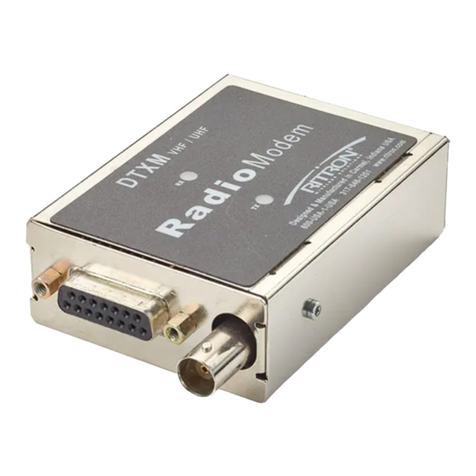
Ritron
Ritron DTXM-460-0BN6I-M-FIPS User manual
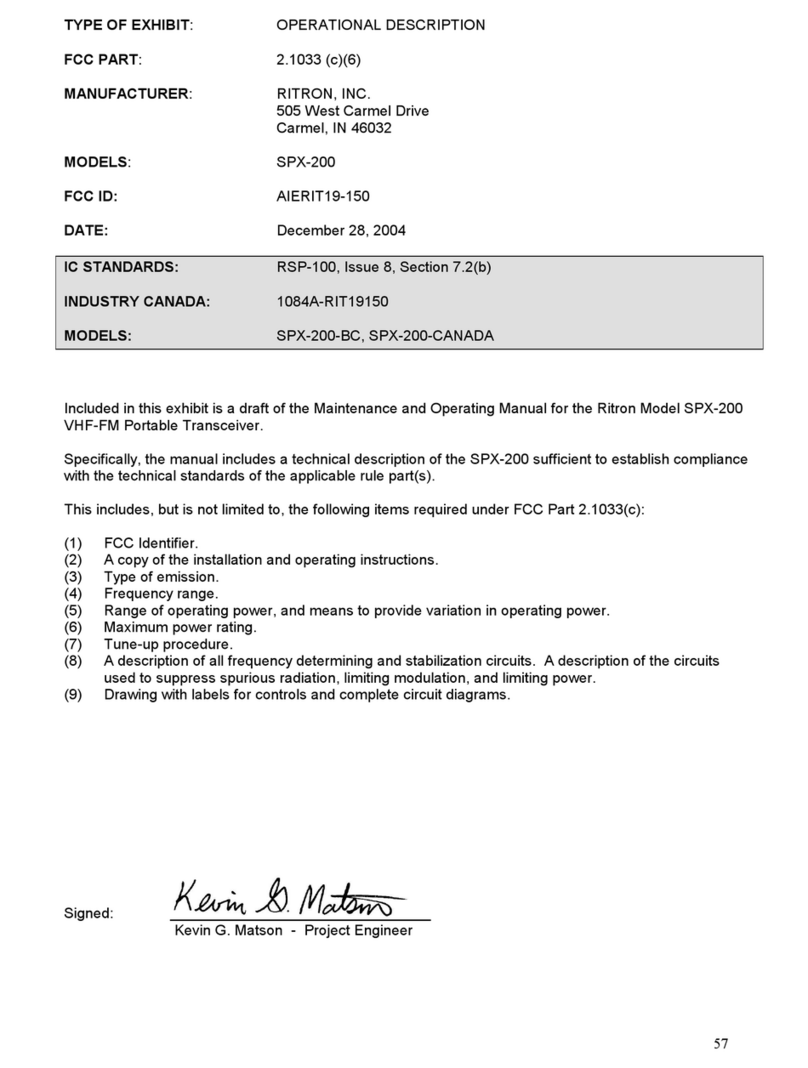
Ritron
Ritron SPX-200 User manual
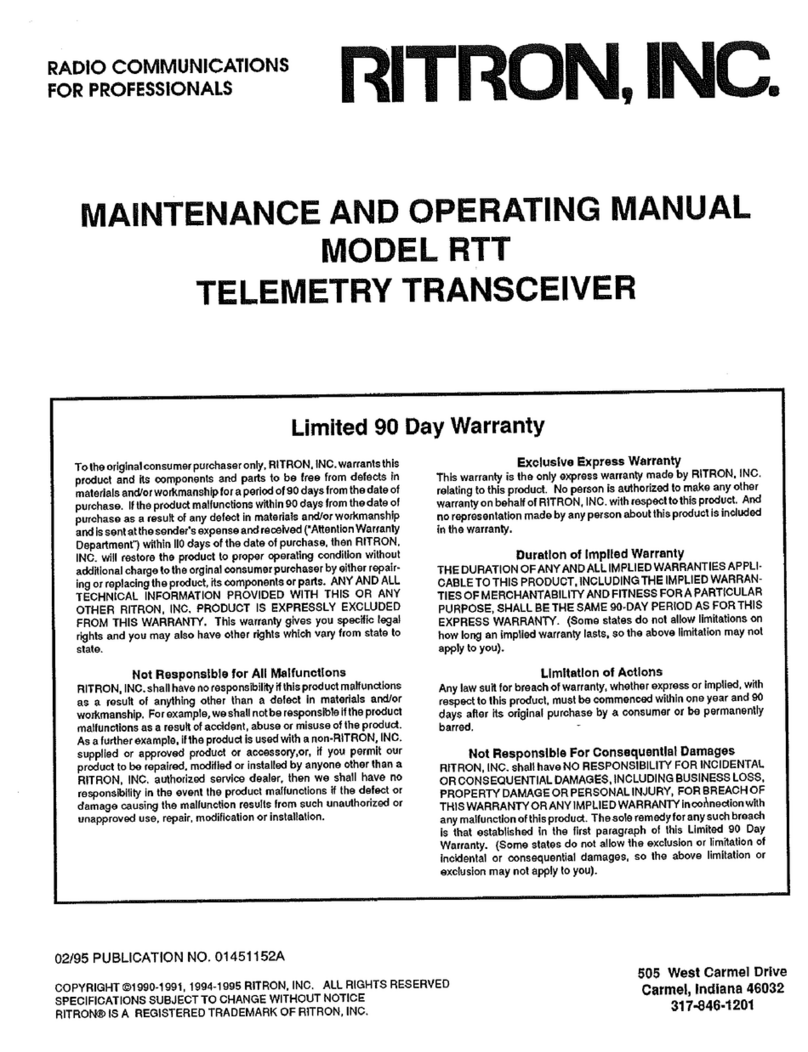
Ritron
Ritron RTT Operating and maintenance manual

Ritron
Ritron SPX-200 User manual

Ritron
Ritron RPM-150 Installation and operating instructions

Ritron
Ritron RPM-150 User manual
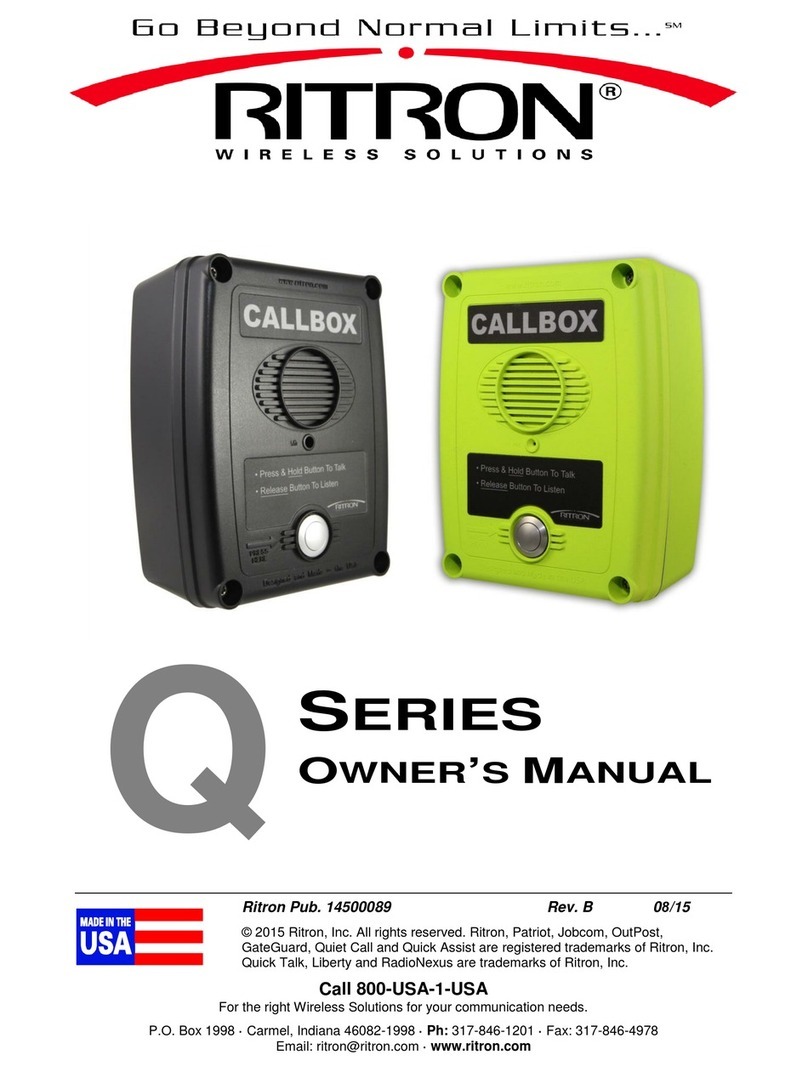
Ritron
Ritron Q Series User manual
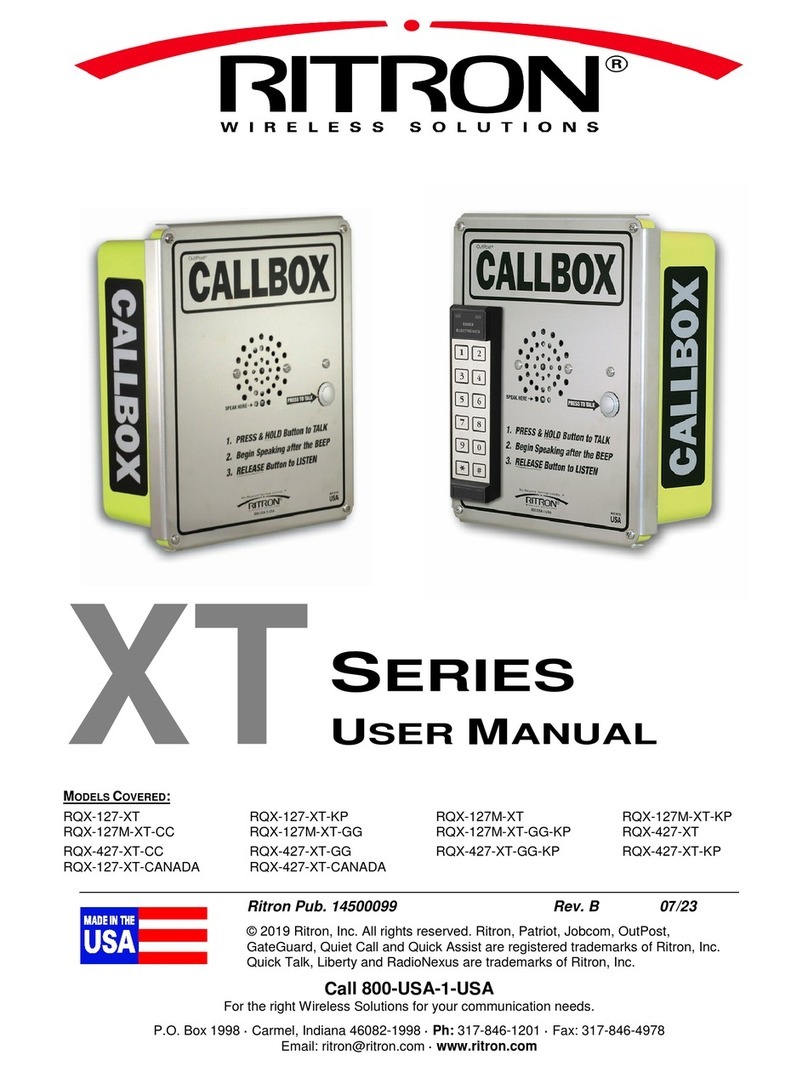
Ritron
Ritron XT Series User manual


